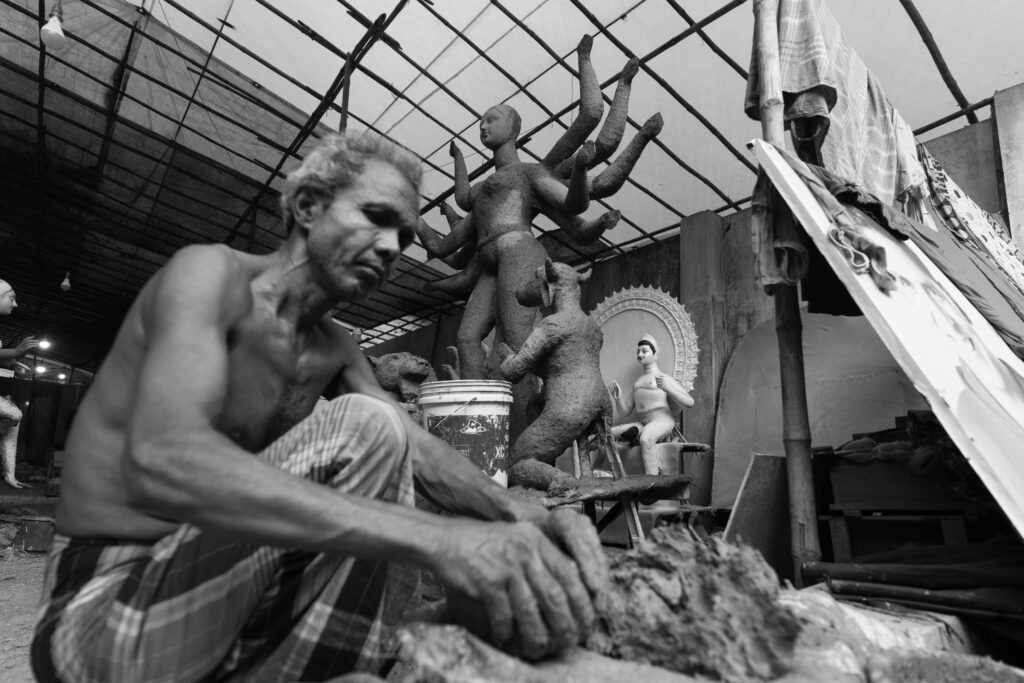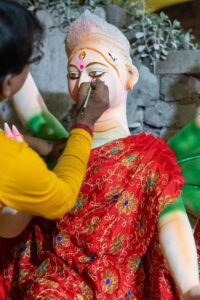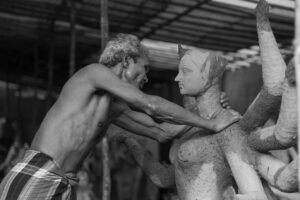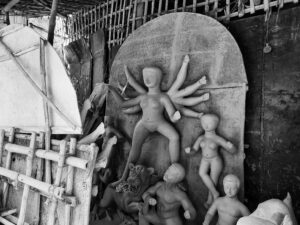Durga Murti -making in Kolkata is deeply intertwined with the grandeur of Durga Puja, a sacred pillar of Hindu traditions. This annual celebration, observed in the Bengali month of Ashwin (September-October), has garnered international recognition from the United Nations Educational, Scientific and Cultural Organization, known as UNESCO. It stands as a living testament to our heritage, passed down through generations and imbued with profound cultural and natural significance.


These facets of our heritage, as designated by UNESCO, hold multifaceted importance, enriching the tapestry of human existence. The artisan community, residing in the potter’s enclaves of Kumortuli and Kalighat, has been the torchbearer of this cultural legacy (Bandopadhyay, 2017). Within the confines of their workshops, these skilled craftsmen toil tirelessly, shaping deities from clay and straw in the heart of this venerable metropolis.
However, the sustainability of this craft remains a pressing concern, essential for preserving the lineage of idol-making amid mounting uncertainties. Amidst these challenges, a transient urban metamorphosis unfolds, birthing a unique public space. This space becomes a vivid simulation of sacred imagery, rites, folk and cultural events, public installations, and an imagined realm coexisting with the tangible. It thrives on the privilege of urbanization and depends on the resourcefulness of its organizers to provide a canvas for the public’s creativity.
Drawing from their narratives and insights gathered from diverse references, it is apparent that with Bengal’s Durga Puja attaining global eminence and recognition, it is incumbent upon us to nurture future generations, encouraging them to embrace this venerated profession and sustain this invaluable wellspring of our cultural heritage.
This remarkable festival draws a multitude of tourists from nearby regions, states, and foreign lands, breathing life into the tourism sector, which encompasses the intricate artistry of clay modeling and Bengal’s textile industry. In line with Hindu traditions that involve myriad pujas throughout the year, most of which feature clay idols, the idol-makers are perpetually engaged in their craft. Durga Puja, in particular, serves as an accelerant, illuminating their artistic pursuits throughout the year.
Durga Murti Making


- Workplace Arrangement:
- Prepare the workspace by firmly anchoring stakes into the ground, defining the designated production area.
- Erect a top structure using parallel bamboo rods, securely fastening them.
- Cover this framework with unfurled tarpaulins, providing essential protection against the elements, shielding the artisans from both scorching sunlight and inclement rain.
- Clay Sourcing:
- Source clay meticulously from various regions across India, including:
- Ganga matti: Clay carefully harvested from the banks of the River Ganga.
- Balu matti: A unique clay variety hailing from eastern India.
- Thickana matti: Another distinct clay variant, also originating in West Bengal.
- Clay collected from river beside
- Source clay meticulously from various regions across India, including:
- Clay Preparation:
- To augment the operability of field clay, renowned for its impeccable consistency, by amalgamating it with rice husk to optimize traction during the artisanal crafting procedure.
- For smaller quantities of clay, manual mixing by hand is employed, while larger quantities necessitate a meticulous foot-assisted amalgamation.
- Idol Shaping:
- For both small and large idols:
- Initiate the process by creating an initial outline using bamboo or a combination of bamboo and sticks.
- Establish the foundational structure with hay, securely fastened with ropes, ensuring it conforms to the desired contours.
- Mold the clay meticulously to fit these pre-defined shapes.
- After thorough drying, apply a layer of clay intermixed with hay, providing the final definition to the idols.


Maa Durga Murti making
- For both small and large idols:
- Facial Details:
- Achieve intricate facial features:
- Utilize a Pop mold and clay sourced from the banks of the River Ganga, known for its capacity to render detailed contours.
- Cover the central portion of the face with freshly mixed clay, ensuring a secure fixation before concealing the head region.
- Achieve intricate facial features:
- Finishing Touches:
- Thoroughly moisten the structure using a brush, focusing on areas requiring finer detailing.
- Craft the hands and feet separately, utilizing either manual craftsmanship or molds, then securely attach them, sometimes employing tethering for precise positioning.
- Ornamental designs for statue frames may be fixed and left to dry, alternating between sheltered shade and invigorating sunlight.
- Coloration:


Durga Murti making - Once the idol is completely dry, initiate the transformative process of color application, either manually or with a precision hand gun, utilizing a thoughtfully selected palette of colors.
- Watercolors are the preferred medium for the artistic rendering.
- Drape attire in accordance with the form of Durga, securing it firmly with nails.
- For Durga’s hair, immerse jute fibers in a rich black hue before affixing them.
- For the lion’s manes, craft jute fibers into compact bundles and secure them.
- The eyes of the idol are typically adorned with either acrylic or poster paints, guided by the discerning choices of the craftsmen.
- Collective Effort:
- As affirmed by the skilled artisans themselves, the creation of these idols is a collaborative endeavor, requiring the collective talents of approximately ten to fifteen dedicated members.
Below is a compilation of the tools and raw materials requisite for the crafting of Durga Murti in Hebbal:
• Clay – The clay of choice hails from Bengaluru, Ganga, Balu, and Thickana Matti, sourced from the Kolkata regions of India, lending it unparalleled suitability for idol construction. • Rice Husk – Invariably integrated with Bengaluru’s clay to confer a desired rigidity to the medium. • Hay – Instrumental in imparting intricate detailing to the sculptures, it is harmoniously combined with the clay. • Gunny Sack and Plastic Materials – Employed for blending and kneading the clay to precise proportions. • Tarpaulin – Assumes the role of a protective cover, shielding the Idols from the elements, namely rain and sunlight. • Sticks and Ropes – Bamboo sticks and related counterparts are the preferred choice for erecting the structural framework of the sculptures. • Stoles – Facilitate the artisans in the crafting of larger-than-life Idols. • Brush – Crucial for applying the finishing touches to the idols with the aid of water. • Watercolours – Sourced predominantly from West Bengal, these watercolours are instrumental in adding vibrant hues to the idols. • Spray Guns – Utilized for the precise application of watercolours onto the intricate surfaces of the sculptures. • Wooden Plank – Plays a pivotal role in arranging the various components of the clay-made idols. • Jute Fibre – Skillfully intermingled with the clay, it augments grip during the idol-making process and is also employed as the ‘hair’ for the deities and lion figurines. • Machete (Big Knife) – Serves as the primary tool for cutting the jute fibre into smaller, more manageable sections. • Sticks and Bamboo Sticks – Ingeniously deployed to provide shelter during the meticulous crafting of the Durga idols. • Poster and Acrylic Colours – Primarily reserved for adorning the intricacies of the idol’s eyes with precision. • Nails – Act as securing agents, anchoring cloth materials as needed for the sculptures. • Maida Paste – Employed to affix ‘hair’ and gilded papers onto the idols, ensuring their resplendent appearance.













